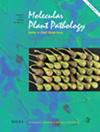Infection-specific transcriptional patterns of the maize pathogen Cochliobolus heterostrophus unravel genes involved in asexual development and virulence
IF 4.8
1区 农林科学
Q1 PLANT SCIENCES
引用次数: 0
Abstract
Southern corn leaf blight (SCLB) caused by Cochliobolus heterostrophus is a destructive disease that threatens global maize (Zea mays) production. Despite many studies being conducted, very little is known about molecular processes employed by the pathogen during infection. There is a need to understand the fungal arms strategy and identify novel functional genes as targets for fungicide development. Transcriptome analysis based on RNA sequencing was carried out across conidia germination and host infection by C. heterostrophus. The present study revealed major changes in C. heterostrophus gene expression during host infection. Several differentially expressed genes (DEGs) induced during C. heterostrophus infection could be involved in the biosynthesis of secondary metabolites, peroxisome, energy metabolism, amino acid degradation and oxidative phosphorylation. In addition, histone acetyltransferase, secreted proteins, peroxisomal proteins, NADPH oxidase and transcription factors were selected for further functional validation. Here, we demonstrated that histone acetyltransferases (Hat2 and Rtt109), secreted proteins (Cel61A and Mep1), peroxisomal proteins (Pex11A and Pex14), NADPH oxidases (NoxA, NoxD and NoxR) and transcription factors (Crz1 and MtfA) play essential roles in C. heterostrophus conidiation, stress adaption and virulence. Taken together, our study revealed major changes in gene expression associated with C. heterostrophus infection and identified a diverse repertoire of genes critical for successful infection.

玉米病原体 Cochliobolus heterostrophus 的感染特异性转录模式揭示了涉及无性发育和毒力的基因
由异养杆孢菌(Cochliobolus heterostrophus)引起的南方玉米叶枯病(SCLB)是一种破坏性病害,威胁着全球玉米(Zea mays)的生产。尽管已经开展了许多研究,但人们对病原体在感染过程中所采用的分子过程知之甚少。有必要了解真菌的武器策略,并确定新的功能基因作为开发杀真菌剂的目标。基于 RNA 测序的转录组分析是在分生孢子萌发和宿主感染异养杆 菌期间进行的。本研究揭示了宿主感染期间异养真菌基因表达的主要变化。异养真菌感染期间诱导的几个差异表达基因(DEGs)可能涉及次级代谢产物的生物合成、过氧化物酶体、能量代谢、氨基酸降解和氧化磷酸化。此外,组蛋白乙酰转移酶、分泌蛋白、过氧化物酶体蛋白、NADPH 氧化酶和转录因子也被选作进一步的功能验证。在这里,我们证明了组蛋白乙酰转移酶(Hat2和Rtt109)、分泌蛋白(Cel61A和Mep1)、过氧物酶体蛋白(Pex11A和Pex14)、NADPH氧化酶(NoxA、NoxD和NoxR)和转录因子(Crz1和MtfA)在异养殖真菌的分生、应激适应和毒力中发挥着重要作用。总之,我们的研究揭示了与异养杆线虫感染相关的基因表达的主要变化,并确定了对成功感染至关重要的多种基因。
本文章由计算机程序翻译,如有差异,请以英文原文为准。
求助全文
约1分钟内获得全文
求助全文
来源期刊

Molecular plant pathology
生物-植物科学
CiteScore
9.40
自引率
4.10%
发文量
120
审稿时长
6-12 weeks
期刊介绍:
Molecular Plant Pathology is now an open access journal. Authors pay an article processing charge to publish in the journal and all articles will be freely available to anyone. BSPP members will be granted a 20% discount on article charges. The Editorial focus and policy of the journal has not be changed and the editorial team will continue to apply the same rigorous standards of peer review and acceptance criteria.
文献相关原料
| 公司名称 | 产品信息 | 采购帮参考价格 |
|---|
 求助内容:
求助内容: 应助结果提醒方式:
应助结果提醒方式:


